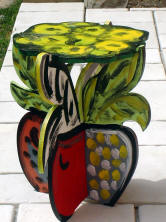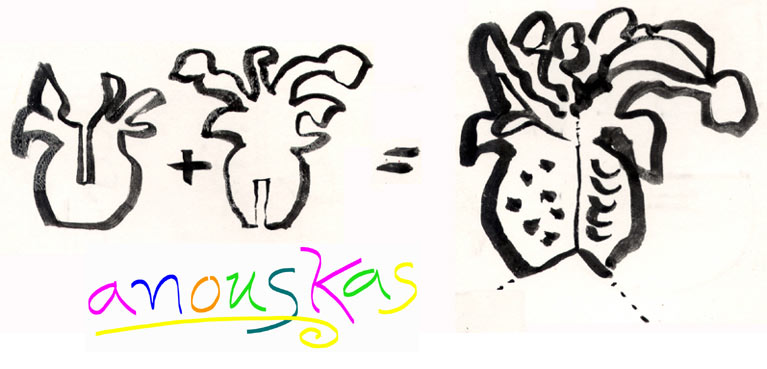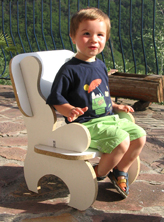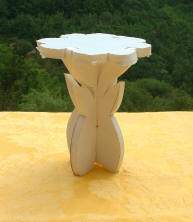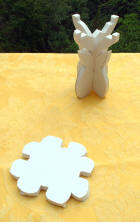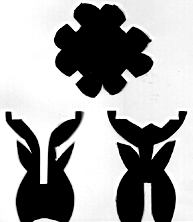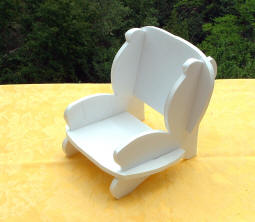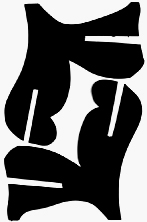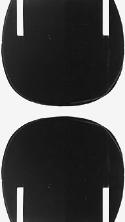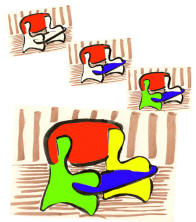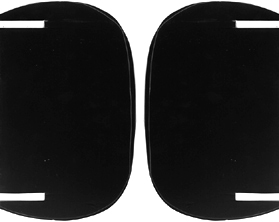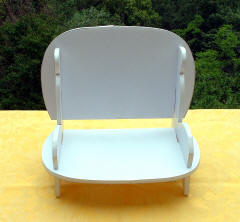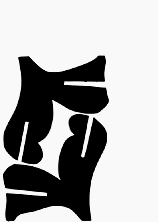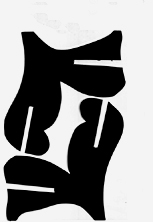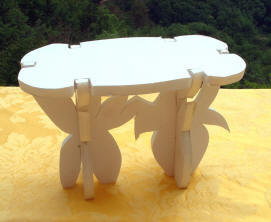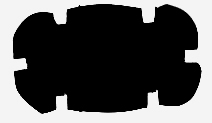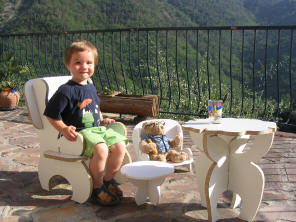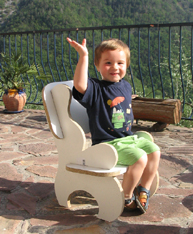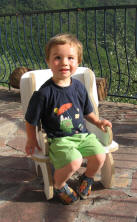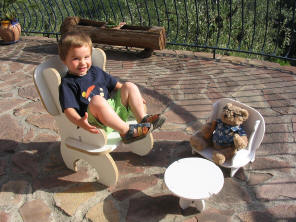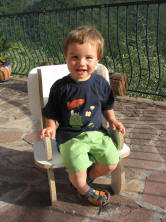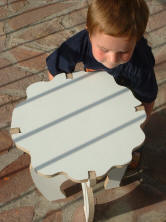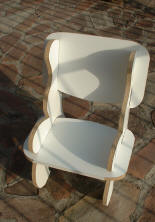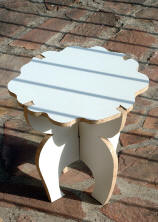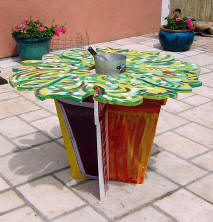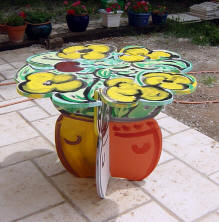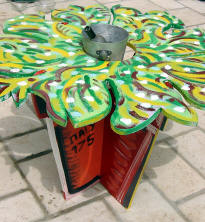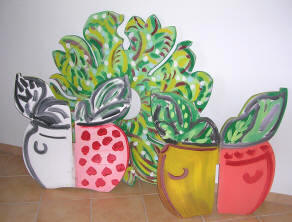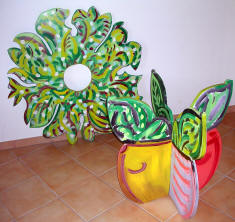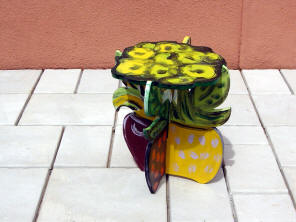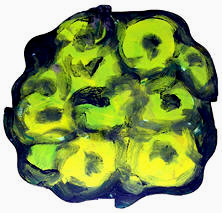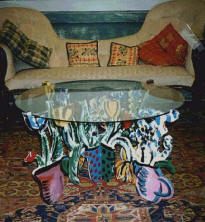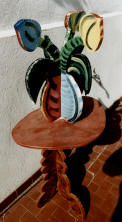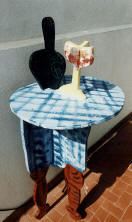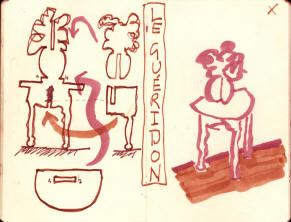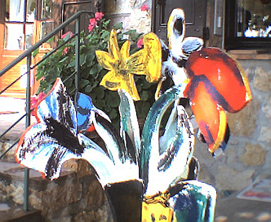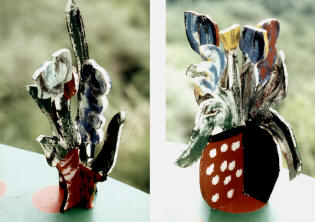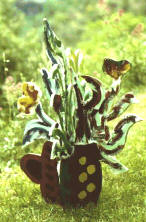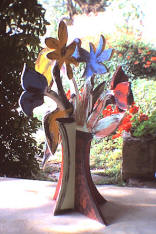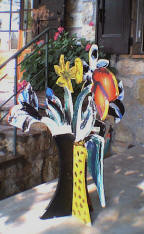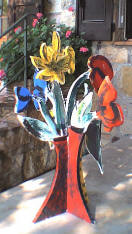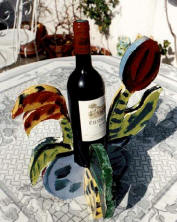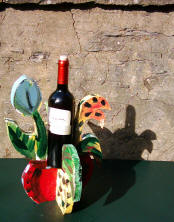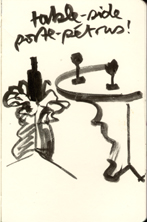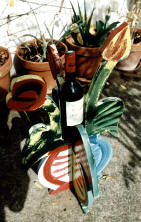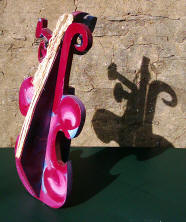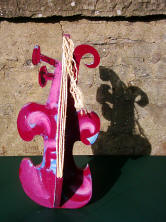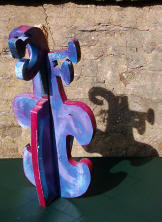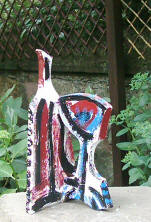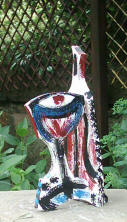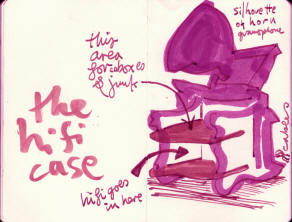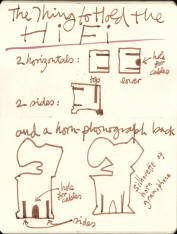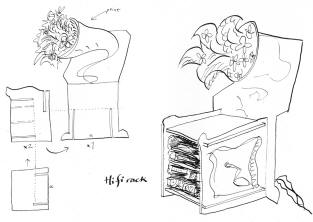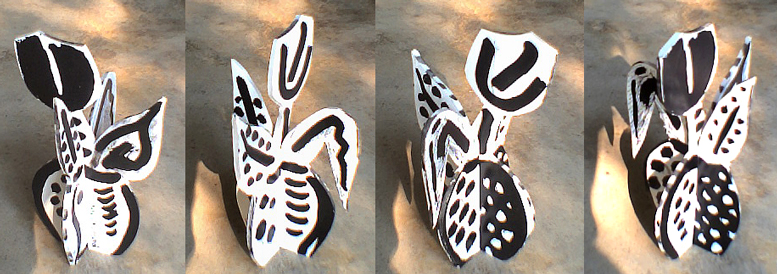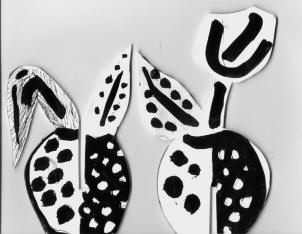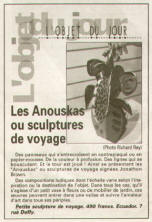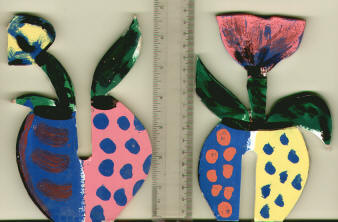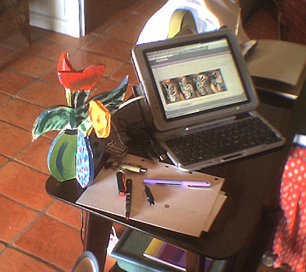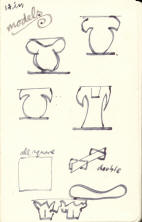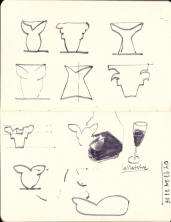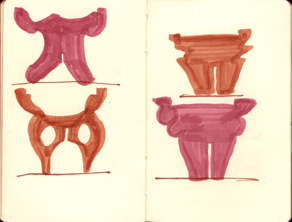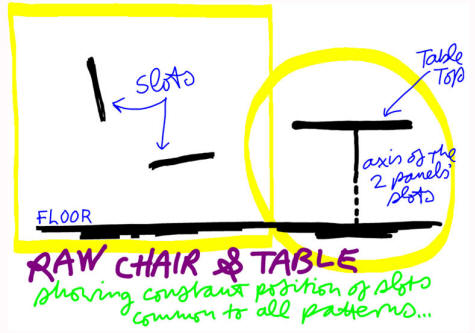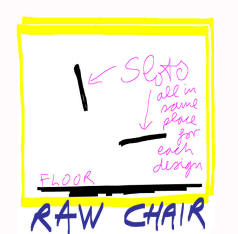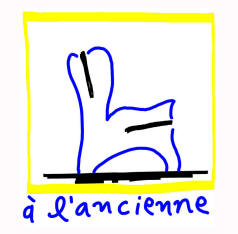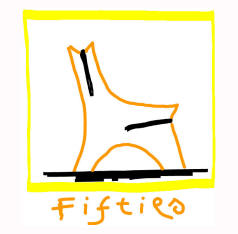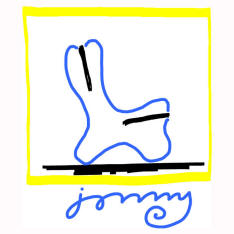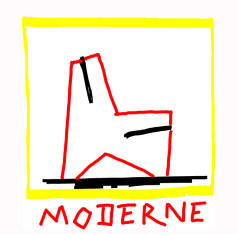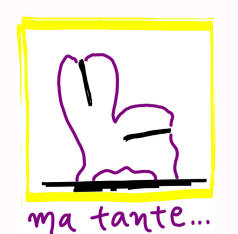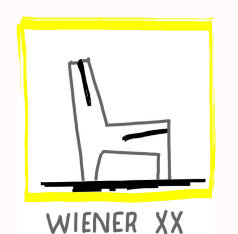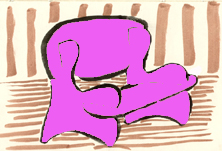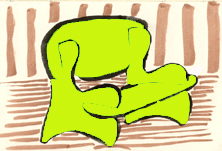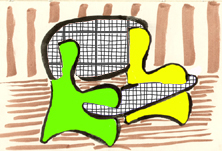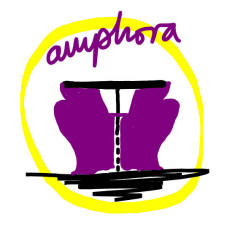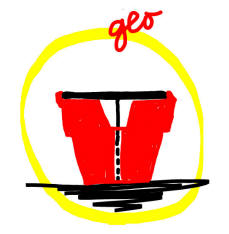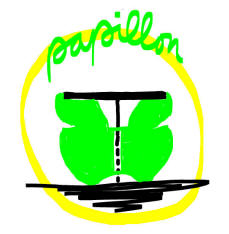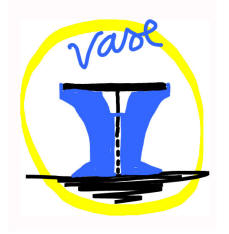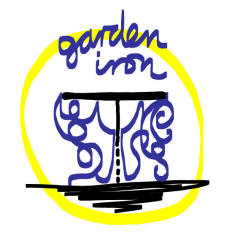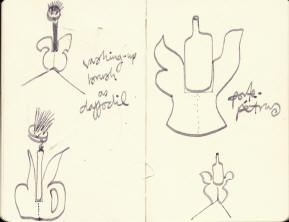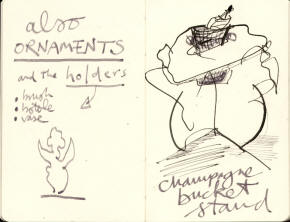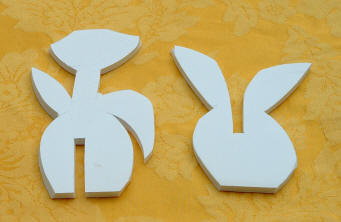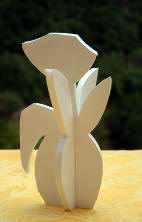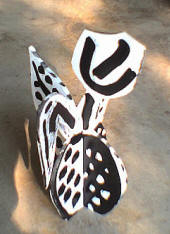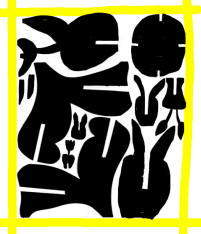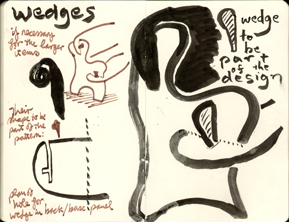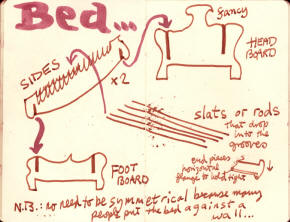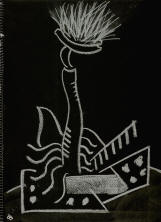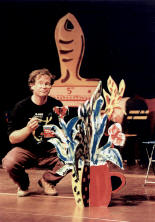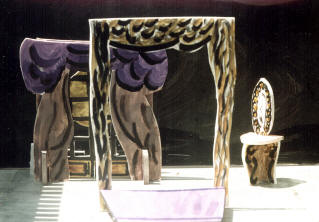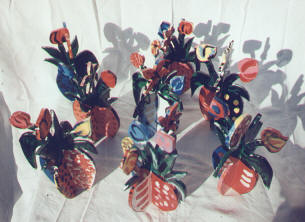INTRODUCTION
This document presents one single, simple idea:
furniture & ornaments made from interlocking panels.
I call this method the Anouska Method. It is a method I have used the artistic expression for many years; this Presentation explores its commercial exploitation in a number of different ways.
This presentation will show some of the versatility in function, design & scale of what is the ultimate method of flat-pack construction, a method that could expand to offer a wide range of useful, convenient as well as elegant, unusual and attractive items.
Of course, I do not suggest doing everything at once; Children's Furniture might be the best start. In what follows I have concentrated on chairs and tables.
Section 1 presents the basic principles;
Section 2 gives a photographic record of various models of designs I have made;
Section 3 deals more technically with questions of design in drawings & illustrations; and
Section 4 looks at remaining technical questions and other possibilities of exploitation.
Section 5 gives the History of the idea — the first sketches are well over 15 years old!
A complete version of this Presentation to be printed on 35 pages of A4 is also available as a pdf file by clicking at the right corner of the top of the page. You will require Acrobat Reader to print this. It is intended as an aid to study rather than as a properly laid-out version of the complete text & images in their smaller versions.
All illustrations, text and material here are © Jonathon Brown and he asserts his droit d'auteur.
Villa Parasol, Alpes-Maritimes, 2006-2020
c o n t e n t s
1 — Anouskas: the Basic Principles
1.i
1.ii
1.iii.i
1.iii.ii
2 — Designs — an Overview in Photographs
2.i
2.ii
2.iii
2.iv
3 — Design — the Generic Elements in more detail
3.i.i
3.i.ii
3.ii
3.iii
3.iv
4 — Other Technical Matters & Beyond
4.i
4.i.i
4.ii
4.iii
5 — History
Note: not all illustrations are thumbnails but click on any illustration with a thin blue edge to obtain a larger image.
The larger images have generally been kept to within 888 pixels wide and 666 high.
Underlining is only used where there is a link to a bookmark within the page.
1
ANOUSKAS — The Basic Principle...
interlocking flat panels requiring no small parts, no screws, brackets or fiddly items that can be lost.
Only one assembly tool is required: your imagination.
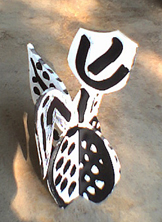
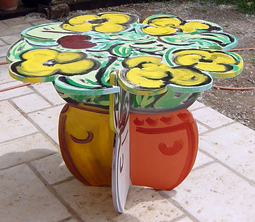
This method can be applied to objects as small as greetings cards or as substantial as a table, with, most importantly, children's furniture in the middle scale.
Advantages...
The Anouska method has the following advantages:
i) it is completely "flat-pack", each item consists only of the constituent panels;
ii) it lends itself to "mix-&-match", where the finish of each panel can be chosen from a different range; and
iii) it can be designed for great interchangeability, or "multiple-mode": where one panel may suit more than one type of item — for instance, it may be either a side panel for single chair or two-seater or a support for a small or long table. The advantage of this uniformity is in production, of course (fewer parts to be tooled & catalogued), but it also gives the customer an easier flexibility;
iv) the use of cut-outs can be geared to an environmentally friendly efficient use of the basic materials and many of the designs emphasise repeated use of any given element in different uses. The chair back is the same as the chair base, and so on.
This presentation concentrates on Children's Furniture and full-size tables, while giving ideas for other applications of the basic principle.
In this introductory section the illustrations are made using foamboard models.
Note that there is in this page almost nothing in the way of technical drawings; all Anouskas so far have been hand-made — even improvised — with knife or saw (!) in hand, used as if it were a brush. This introduction suggests a simple, effective and homogenised production range while also elaborating on all the future ramifications that that could have, based on the fantasies the artist has already exploited...
1.i (anouskas, the basic principle, section i)
THE Ultimate Flat-Pack
Tables will consist of 3 panels; and chairs of 4. All items will simply consist of slotted panels that slide into each other. Most so-called ornaments need only two panels. In this presentation the chairs follow a design based on an Arm Chair and are called "Ugolino"; and the tables follow designs based on a vase or bowl of flowers.
For instance, the simple Flower Side-Table is assembled out of the elements as shown here:
Note that the table-top can be used as a tray, e.g. for bringing drinks to guests, since the base is attractive just as a sort of sculpture; also different table-tops would be available for any given size or pattern of table base.
And the single Arm Chair is assembled out of the elements as shown here:
For very large items under some extra strain — such as a bed or large wardrobe — it may be necessary to introduce wedges, but these would still be basic elements of the same material; there would never be screws or flanges needing 'assembly'. The wedges would be incorporated into the aesthetic of the design, moreover. For further treatment of this, see 4.ii.
1.ii (anouskas, the basic principle, section ii)
Mix-&-Match — FINISHES
The panels can be made available in all sorts of finishes: solid colours, patterned designs &c.
Therefore a 4-panel chair might be made up by choosing one each of four different colours or patterns:
This applies easiy to all of the elements of any piece of furniture. A flower-table might be made of one decorated colourful pattern and the other just in black-&-white.
See 3.i.ii below for greater detail and further illustration of chair finishes.
NOTE: Mix-&-Match — MATERIALs
Exactly the same applies to materials: a wooden base for a table could have a wooden or glass top.
Moreover, by keeping size patterns uniform, a glass top and a wooden top could be interchangeable between e.g. a wooden and a metal table-base... as explained in the next section, Multiple-Mode.
1.iii.i (anouskas, the basic principle, section iii.i)
Multiple-Mode — CHAIR PANELS
In the illustration below it can be seen that the same side panels can be used whether the set of back & base panels be for a 1- or 2-seater:
and
or
make single
or
double
Equally, the side panels might be done in three different sizes — yet made to accommodate the same back/base panels; therefore, especially in the range for children, the chair can be made to suit the child and can evolve with the child without buying the whole chair every time!
There might be three sizes of side available for each size of back & base.
or
or
goes with
Well, how well does your chair fit you?!
1.iii.ii (anouskas, the basic principle, section iii.ii)
Multiple-Mode — TABLE PANELS
Here we see how the same pair of small flower-table supports can be used for a small table (a+b), or as part of the construction of a larger table (a+c+d):
a
b
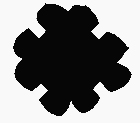
a
c
d
One great environmental and economic advantage of this uniformity is in production, of course (fewer parts to be tooled & catalogued) but it also gives the customer easier flexibility; the two panels needed to make a long table out of the two supports of the small table can easily be [flat-]packed away when not in use!
2
Designs — an overview in photographs
2.i Furniture for children and cuddlies: a table & chair each
2.ii & its application at full size: garden & indoor tables
2.iii ornaments, SCULPTURES and smaller practical items
2.iv greetings cards and lightweight 'travel sculptures'
2.i (designs, an overview in photographs, section i)
FURNITURE for Children & Cuddlies IN PHOTOGRAPHS:
THE "UGOLINO"
A Table & Chair for Each
Here are Ugo and Stocky-Bear at their Anouska chairs & tables in the evening sun.
Stocky-Bear's chair & table are modelled in foamboard and the Ugolino chair & table have been made in coated chipboard, strong enough for children. (The chipboard panel edges have been left unfinished to help make visible the contours.)

Ugo is 2 years old and with very little help from Béatrice managed to put his chair together — hooray!

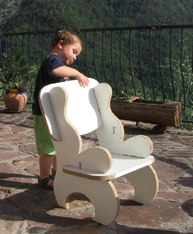
It is easy to see, in the juxtaposition of the set for Ugo and the set for Stocky-Bear, that the same principles can apply to any scale, provided the right material is chosen; adults & children can share the same design!
2.ii (designs, an overview in photographs, section ii)
FURNITURE IN PHOTOGRAPHS:
full-size GARDEN & indoor Tables
2.ii.i A Pair of Flower Tables
2.ii.ii A small Flower-Table & Tray
2.ii.iii A Glass-Top Flower-Pot Table
2.ii.iv A Pair of Fantasy Guéridons
2.ii.i
A PAIR OF FLOWER-TABLES
Created for a Jazz Festival in Lorgues (Var, France), these two tables are made entirely of three panels of hand-cut plywood, painted. There are no lugs, no wedges, no screws — just three panels.
There is a Flower-Pot table (above left) and a Bowl-of-Flowers table (above right), and all the panels are interchangeable!
The two tops are (above right) a solid top, of flowers like pansies, and (left) a leafy top with a hole in the middle for a champagne-bucket — it also has slots in~between the leaves, into which you can slide champagne glasses upside down, hanging from their bases... Or you could put a Flower-Pot in where the Chqmpqgne Bucket goes... Anything goes with Anouskas!
Below, you can see the constituent parts of the Champagne Bucket table but on this occasion with the Flower-Bowl base instead of the Plower-Pot. The slots for the glasses are clearly visible too.
Of course the whole table is absolutely 'flat-pack', literally just a set of three panels!
2.ii.ii
A SMALL FLOWER-TABLE & TRAY
Here the same principle applies, but with the smaller tables the Flower Top (below right) can be used as a tray for bringing snacks or drinks.
Note that the slots have been made less exactly fitting so that putting the tray down on the base is easier for when the tray is charged with plates or glasses... (This is discussed in IV.ii, on Lugs & Wedges.) Yes, the Pansy Table Top doubles as a tray!
2.ii.iii
A GLASS-TOP FLOWER-POT TABLE
The table-top can also be made in glass... — as here in a table commissioned in 1997 by the Galerie LaSalle in Monte Carlo.
In IV.ii below I discuss the possibilities of mix-&-match using glass.
2.ii.iv
A PAIR OF FANTASY GUéRIDONS...
These are almost sculptures rather than tables! — but they work perfectly well as tables against a wall. (There is no reason why the idea should not apply to free-standing tables, of course.) These were a commission for a villa in Nice.
Note that in the second example (above, right) the table-top sculpture is of a bottle of brandy and a glass; here a small extra fifth element slotted in on top to give the glass a three-dimensional look... Later designs can be made ever more complex, still all only requiring flat-pack interlocking panels...
2.iii (designs, an overview in photographs, section iii)
ornaments, SCULPTURES & smaller table objects
2.iii.i Flower-Sculptures (impractical...)
2.iii.ii The so-called Porte-Pétrus bottle-stand (practical!)
2.iii.iii A Washing-up-Brush Daffodil (fun!)
2.iii.iv Sculptures: a 'Cello, Bottle-&-Glass and an Ocean Wave &c
2.iii.i
FLOWER-SCULPTURES
To complement the ethos of Anouska furniture there are sculptures and practical items that use the Anoushka method with an artictic flair. My hand-made examples have always been exhibited as "Fleurs du Bien". The most obvious ornaments are the series of Flower Sculptures (and their related smaller Travel Sculptures) and, dealt with in the following separate chapter below, the Greetings Cards.
Flower-sculptures shown here were made mostly in chipboard and MDF, but for manufacture would be printed or plain, in their abstract shapes. They could be made in plain wood, simple colours or with patterns printed on.
Here are some examples, even as garden ornamentation...
A Set of Three, small, medium and bigger...
Three angles upon An Important Daffodil Anouska. [private collection, France]
2.ii.i
THE SO-CALLED PORTE-PéTRUS...
A BOTTLE-STAND IN THE FORM OF A VASE OF FLOWERS
Created as a commission for a villa in St Raphael, the witty idea of making the vase hold a bottle has earned the optimistic nick-name "Porte-Pétrus"...
A second model was also made for a Swedish art-dealer, not to be placed on the table (as above) but on the floor, to hold the bottle at elbow-height to the host... obviously the same idea could be applied to hold an ice-bucket or tray...
2.iii.iii
WASHING-UP BRUSH DAFFY Pot
Based on perhaps my earliest such idea (see History), one of the earliest 'practical' Anouskas was a set of leaves into which fitted the washing-up brush which then miraculously became a daffodil! There is no known photograph of the original but it is still in use in Sussex! (This type of wooden-stemmed brush is nowadays hard to find — but I know a shop in Santo Spirito in Florence!)
2.iii.iv
SCULPTURES:
A 'CELLO, BOTTLE-&-GLASS AND AN OCEAN WAVE &c..
The following Anouska sculptures have been exhibited and collected in various parts of the world and are shown here to indicate some of the future decorative applications of the method.
A Mellow 'Cello...
A Bottle & Glass...
A Finals' Good-Luck present for a nephew; possibly the Cubist influence to the fore?!
An Ocean Wave...
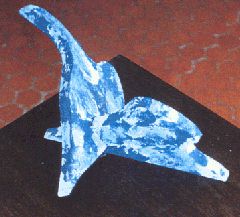
Two Anouska waves were exhibited at the Musée international d'Art naif Anatole Jakowsky, Nice, as part of an exhibition entitled "Les Magiciens de la Mer"; 1999
A Casing for Mini Hi-Fi...
This was made in 1996 for Sabrina Scott of Children's Academy on Tour but no photographs remain; the drawings give some idea of the way the Anouska method can also be adapted to extremely practical & neat a purpose while giving a completely different 'take' on everyday things...
Again, the Hi-Fi case is made only of 4 panels and they are completely flat.
The back panel was cut in the silhouette of a horn gramophone with its horn & open lid, while just by their detailing the side panels suggest the elaborate carving & framing of the woodwork of such an instrument... A big bunch of flowers was painted as if exploding from the 'horn'; of course, the basic principle would apply to a Hi-Fi holder without the allusion to a horn...
The dimensions were carefully exact to the particular Hi-Fi in question and had 'mouse-holes' at the back ready to take those cluttersome cables!
2.iv (designs, an overview in photographs, section iv)
Greetings Cards & Travel Sculptures
Greetings Cards
The premise for these is that they should be light in weight and sold with envelopes; they could be made from heavy card and should show their postage weight, so that the rate can easily be established.
The first of these were always made in black-&-white on foamboard, in a more-or-less Matisse style...
The designs might be in colour but here we meet the fact that in black & white the effect can be even more strong and imposing.
These photographs show how they change character from every different viewpoint. This example fitted into A5 and into the lowest band of postage [<20g] with envelope.
Here are the two panels — and remember, they can be slotted into each other two different ways, the other way around...
Travel Sculptures
Nice-Matin celebrated the idea of Travel Sculptures — "sculptures de voyage" — on 11th December, 1998!
The idea of Travel Sculptures is that for people on the move a lot, usually condemned to hotel rooms with little or no personality, you put your travel sculpture on the dressing-table or by the bed and immediately the sculpture takes over the personality of the room and gives it a homey, familiar feeling.
They have usually been made in foamboard or light plywood, within A4 dimensions so as to fit a briefcase...
Travel Sculptures have long been a popular gift from JB — there is even a British Ambassador who carries one with him — and might benefit from being made in a lightweight material slightly sturdier than board.
This is the one at the desk as I write this presentation... It lives happily in my computer bag to cheer me up on every occasion.
3
Design — the Generic Elements
Preliminary RemarkS ON FORM & FINIsH
All the designs of all Anouska forms depend simply on the slots: their position and their relative depth determine the success or not of an idea.
Once the pattern of the slots has been decided, the surrounding shape of the panel is open to vast variation.

In these sketches we see how the essential support in a table, for instance (above left), is determined by three points around the axis of symmetry: the lug or slot at the top, the meeting point of the male & female elements of the vertical slot, and the position of the outer limit of the base, the 'foot' as it were. In the other sketch (above right) we see how radically the panel can be pared away till it is in effect a scaffold.
In the next sketches we see how I have begun to play with the freedom of form given by this structural simplicity.
For instance, the Ugolino chair discussed above has curved, comfy contours of a favourite, slightly old-fashioned arm-chair.
And the flower-pot bases can have all sorts of shapes too; here are some sketched at a bar called la Victoire (hence the pichet & glass of red wine in their midst)...
(At the foot of the first page above is a sketch of the way the long table can use the two elements of a small round table, which we saw at 1.iii.ii, Multiple-Mode — Table Panels.)
As I say, all Anouska forms depend simply on the position of the slots: once the pattern of the slots has been decided, the surrounding shape of the panel is open to vast variation.
A NEW RANGE EVERY YEAR...
NEW THEMES AND MANY MATERIALS
All sorts of themes are possible. All sorts of finishes. All types of material...
I envisage marketing a new range each year, where the consistency of the positioning of essential support would mean that each successive range fits with any range before: the combinations are endless and give the client all sorts of possibilities for humour, let alone simple re-cycling of the old with the new...
Here are some doodles on the idea of wave-shapes as the base of a long table:
Other themes for shapes or decoration might be flowers (as we already have seen), animals (especially fun for children, possibly in silhouettes they can colour or decorate), brushstroke shapes (I am thinking of the little-known sculptures by Roy Lichtenstein), — even Chinese characters... Abstract shapes & silhouettes lend themselves to plain coloured finishes, but the possibility of printed decoration opens the possibilites even further.
I nerarly forgot, ornamental animals were made on a holiday with some children some years ago — I made rabbits and cats from interlocking panels of cardboard boxes from the local shop, and left them in the fields around the house; just shapes, no decoration at all.
It might be that the success of the range means that we ask a different artist or designer each year to do a table & chair within the structural parameters of the existing range.
Therefore, related to form, is the question of finish
— plain wood, plain colour, patterns such as blobs or checks, prints such as painted flowers and so on...
and therefore, related to finish, is the question of material
— noble wood, basic wood, plywood, mdf, plastic, metal and of course glass for some tops or even smaller bases...
The principle of Anouska structure can be exploited both by mass production and by craftsman's production, hand-made and hand-decorated (as all are in this presentation). Imagine mahogany! Or steel!!
Now I continue to discuss Designs in more detail as follows:
3.i.ii CHAIRS — FINISHES
3.ii TABLES
3.iii ORNAMENTS & SCULPTURES
3.iv GREETINGS CARDS
3.i (designs, the generic elements, section i)
CHAIRS
3.i.i (designs, the generic elements, section i.i)
CHAIRS — FORMS
Whatever the style of the design, the basic structural strategy of the positioning of the slots would remain constant for each size.
Note that the two chairs shown here use the same shape for the back and the base panels, again simplifying production and stock costs.
Side panels can be in more sizes than back and base panels, allowing especially children's chairs to evolve, retaining the back & base panels as larger side panels are required. Reminder: see I.iii.i above.
Yes, there is no reason the designs cannot have holes!!
3.i.ii (designs, the generic elements, section i.ii)
CHAIRS — FINISHES
The basic chair...
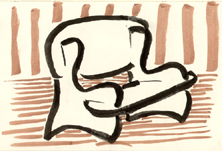
can be made from all sorts of finishes.
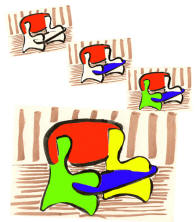
Plain colours, patterns, even images...
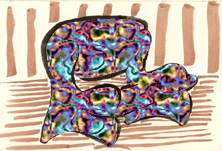
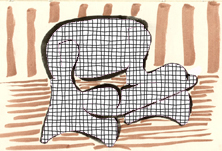
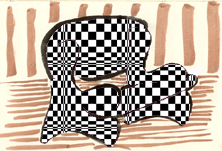
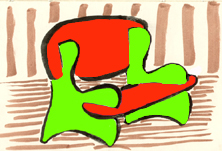
3.ii (designs, the generic elements, section ii)
TABLES
Exactly the same remarks apply to Tables as for Chairs.
Here are some ideas for table shapes all of which conform to the 'raw' pattern and would fit in with each other in odd combinations as well as use the same shape of top.
Remember, as with chair sides and bases, these panels could be sold separately, as 'up' panel and 'down' panel, so that Mix-&-Match applies at every stage.
The Garden Table might be made in bent or stamped metal, taking a wooden or glass top. And with its floral motifs it would look good with no top at all while we wait for the drinks to come — or summer...
3.iii (designs, the generic elements, section iii)
ORNAMENTS & SCULPTURES
All the remarks above apply to smaller, practical or ornamental applications. In all cases it just doesn't matter which way round the pieces are assembled, the symmetry of the slot design takes care of stability and the decorative finish will match... or mix!
Note also that for the upright supports for the Champagne Bucket Stand, these can be designed such that if a solid Table Top is put on, or if it has no top on at all, it will still make sense, it will still look 'right'. Indeed, all table supports could be designed to be able to take a Champagne Bucket (or flower vase), if assembled with a Top that has the hole in it.
Especially for the sculptures, it will be seen here that the elements here are not only no longer symmetrical but that the axis of the slot may be at an angle to the vertical...
Ornamental Sculpture of a Bottle & Glass (see 2.iii.iv above for photograph)
Ornamental Sculpture of a Brush & Paint-Pot
3.iv (designs, the generic elements, section iv)
Greetings Cards &c.
The generic elements of the greetings cards are exactly as they would be for the bigger items, except that care must be taken to design them within the usual envelope sizes and if possible to remain under the usual ordinary postal rate. In foamboard an A5 card in 2 panels in its envelope can be done to weigh 19.5g.
The material I use for hand-made cards is foamboard of 3mm or 5mm thickness but stout cardboard may be easier for manufacture & printing.
Note that blank cards could be sold again for children to colour and decorate themselves... or grown-ups too!
4
OTHER TECHNICAL MATTERS
& Future Development
Here I imagine a booth where all the furniture has been assembled in the Anouska principle... Shelves, chairs, tables — and upstairs, the beds and so on, for grown-ups, children and cuddlies alike.
The range and scale of this ambition prompts one or two clarifications as to technical matters.
4.i Materials
The models & maquettes I have made have taken ordinary "diy" materials such as foamboard cut with a modelling knife or plywood cut with an electric hand jig-saw as their basis. For proper manufacture decisions need to be made about material and methods, perhaps after experimentation — cut-outs or stamping? for instance, is one question outwith my experience or expertise. It may even be possible to use glass for supports in a particular range, e.g. of smaller tables.
It may seem that a grown-up sofa made in the Anouska method in plywood will be heavy, but it has to be remembered that in transport each panel is a quarter of the weight of the whole, thus making transport relatively convenient for an item that gives that wonderful solidity and a sense of importance we associate with the great furniture of the past.
Note also that for outdoor furniture there is the possibility of using metal as the support and to have table-tops in patterned metal or even glass. (Myself, I do not like plexiglass.) The glass could be coloured.
4.i.i Anouskas, Materials and the Environment
As with all wooden products Anouskas will have very low environmental impact especially as non-wooden fasteners are not needed. The modularity and flexibility also strengthen its eco credentials, especially the way for instance the Ugolino Children's Chairs 'grow' with the child and do not need to be entirely discarded as the child grows. Other strengths are ease of repair, disassembly and recycling as well, of course, as the use of sustainably managed forests.
The manufacturing cutting sheet for Anouskas might contain several shapes and leave very little unused...
even to the limit of perfect fit!
Anouskas go green!
Here the panel from which the Square Planet Chair would be cut/stamped is almost 98% used, in a squared-off solid design (above) where even the hole in the panel — designed to lighten it — is a rectangular shape from which another Anouska would be cut or stamped, perhaps a Cuddlies' Chair....
Careful design of the cut-outs to be taken from any given sheet should ensure a minimum of waste. From the sprue of a chair sheet could be cut the panels for flowers or ornaments and so on...
4.ii Lugs & Wedges
The design of the lugs in such as Table-Tops and so on, is crucial: the small indented lug gives greatest rigidity but for trays a gradual, one-sided slot is much easier for setting down.
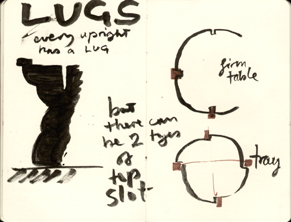
The designs I have made have never used wedges but I can see that at a certain scale wedges may be required for security and stability, especially for large items such as beds, 2-seaters or sofas. It is important that this structural necessity become part of the design, so that for instance in the old-fashioned comfy arm-chair look of a sofa the wedges add to the sense of curvature and curly welcome that the seat offers.
4.iii Beds & Beyond...
The range described in detail in this presentation is mainly concerned with tables & chairs; here however is a preliminary sketch of how the mattress support of a bed would be done in the Anouska method.
Once again, as with the Chair designs above, the shapes of the designs can allude to all sorts of ideas, Louis XIV or Bauhaus, gothic or van Gogh, Dali or Picasso!
Fantasy Bedhead shapes...
V
History
The idea of using a washing-up brush in a structure and as a slightly surreal daffodil dates from sketches done in around 1983, when I first started to look properly at Cubist painting.
Here is one of them.
Drawing for Daffodil Washing-up Brush & Structure, soft crayon on black paper, 41x32cms; c.1983/4
As far as actual sculptures or structures are concerned, I had made a set of large tulips for a house in Edinburgh, in 1992; they were nearly 6' tall, in chipboard, and simply painted in very plain colours to harmonise with the wall colours in a house being done up for rental. (There is no known photograph of these to have survived.)
The first Anouska so-called was made in foamboard as a greetings card for the daughter of a friend, in 1993 or 1994; her name is Anouska and her name has 'stuck' as a generic name for JB's sculptures in this method. The first ones included animals — fat cats — but were mainly versions of vases of flowers.
Adding the finishing touches; JB at the Salle des Variétés, Monte Carlo; 1995. (photograph courtesy Martin Scott)
Then in 1995 the method was used in my décor for a stage production of a cabaret in Monte Carlo, the theme being out-sized large brushes & paint-pots constructed so that their horizontal elements could serve as café tables; the stage was also dotted about with Anouska flower sculptures and the first half was in full colour, changing unexpectedly for the second half (by reversing the panels) to the more dramatic, more striking black-&-white!
As a means of portable stage sets the idea has many advantages and here below is a maquette I made for a production of a monologue by Marguérite Duras for the Lucénaire in Paris. Here is a four-poster bed seen as if from in-bed, a guéridon de boudoir, and window-curtains with a setting sun through the grid of panes. The entire small set would fit on a car roof-rack.
Thereafter came the idea of a 'travel sculptures' — that's to say small, portable sculptures in two panels which people on the move can assemble in their otherwise anonymous hotel rooms when they are on the move. The 'family group' of Travel Sculptures below was made for an exhibition in Sweden in 1999 and for the only the one time were cut by a carpenter as a batch, using a desk jig-saw. This was my first experiment with 'mass production'; I then hand-painted each one...
Eventually I examined the way in which the Anouska principle could be applied to the mass market in all its variety and versatility — the idea was submitted to the wide world in October 2006 and the rest is history...?
VI
CONTACT
Jonathon Brown
Villa Parasol
1, route de la Mairie
06670 DURANUS
Alpes-Maritimes
France
telephones:
France mobile: +33 (0)668 030 228
Great Britain mobile: + 44 (0)77 22 06 1992
e-mail: villaparasol@aol.com
web-site: www.villaparasol.com
© Jonathon Brown 1984-2006
